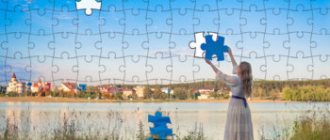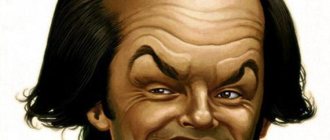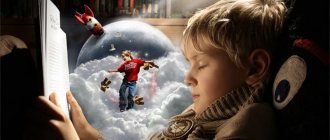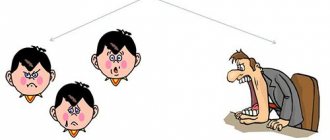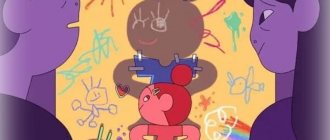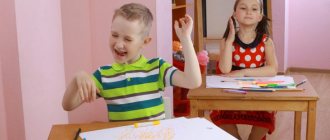Imagination is the ability of consciousness to create images, ideas, ideas and manipulate them; plays a key role in the following mental processes: modeling, planning, creativity, play, human memory. A type of creative imagination is Fantasy. Imagination is one of the forms of mental reflection of the world. The most traditional point of view is the definition of imagination as a process (A.V. Petrovsky and M.G. Yaroshevsky, V.G. Kazakov and L.L. Kondratyeva, etc.). According to M.V. Gamezo and I.A. Domashenko: “Imagination is a mental process consisting of the creation of new images (ideas) by processing the material of perceptions and ideas obtained in previous experience.” Domestic authors also consider this phenomenon as an ability (V. T. Kudryavtsev, L. S. Vygotsky) and as a specific activity (L. D. Stolyarenko, B. M. Teplov). Taking into account the complex functional structure, L. S. Vygotsky considered the use of the concept of a psychological system adequate.
According to E.V. Ilyenkov, the traditional understanding of imagination reflects only its derivative function. The main thing is that it allows you to see what is, what lies before your eyes, that is, the main function of the imagination is to transform an optical phenomenon on the surface of the retina into the image of an external thing.
Classification of imagination processes
According to the results:
- Reproductive imagination. (recreation of reality as it is)
- Productive (creative) imagination with relative novelty of images;
- with absolute novelty of images.
By degree of focus:
- active (voluntary) - includes reconstructive and creative imagination.
- passive (involuntary) - involves unintentional and unpredictable imagination.
By type of images:
- specific
- abstract
By methods of imagination:
- agglutination - the connection of objects that are not connected in reality;
- hyperbolization - increasing or decreasing an object and its parts;
- schematization - highlighting differences and identifying similarities;
- typification - highlighting the essential, repeating in homogeneous phenomena.
According to the degree of volitional effort:
- deliberate
- unintentional
Types of imagination
- Active (voluntary) imagination is a conscious, purposeful process, always aimed at fulfilling a creative or personal task. The participation of volitional processes in this case is maximum: the process of active imagination is controlled and directed by the person himself. Active imagination is divided into active recreative and active creative imagination. Active recreating imagination consists of imagining something that is not directly perceived by the senses, but created in the mind in accordance with the description (for example, in the process of listening to an interlocutor, reading books).
- Unlike active recreation, the process of active creative imagination occurs without relying on description. This process is carried out by a person independently (for example, the work of an artist, writer).
- Passive intentional imagination is a type of imagination whose products are dreams and daydreams. This is the creation of an image of the desired future, which can act as a unique form of psychological protection, providing temporary escape from problems that have arisen, which contributes to a certain neutralization of the negative mental state and ensuring the preservation of regulatory mechanisms while reducing the overall activity of a person. What a person needs, but which he cannot achieve in reality, while having a strong need, is achieved in a passive voluntary imagination in order to get out of the state of frustration.
Mechanisms of imagination
- agglutination - creating a new image from parts of other images
- hyperbolization - increasing or decreasing an object and its parts
- schematization - smoothing out differences between objects and identifying their similarities
- accentuation - emphasizing the features of objects
- typification - highlighting what is repeated and essential in homogeneous phenomena
There are conditions that contribute to finding a creative solution: observation, ease of combination, sensitivity to the manifestation of problems.
Guilford used the term “divergent thinking” instead of “imagination.” It means generating new ideas for the purpose of human self-expression. Characteristics of divergent thinking:
- fluency
- flexibility
- originality
- accuracy
Specific Characteristics of Imagination
- Imagination is aimed at creating something new; it is a process involving the creation of new images, ideas and ideas. In this regard, imagination allows a person to go beyond personal experience.
- The new created in the process of imagination is connected with what has already been perceived by a person. Elements of the new, created by the imagination, represent what is already known, existing in reality, but the imagination transforms the relationships between really existing objects and thereby achieves the effect of novelty.
- Imagination is inextricably linked with a person’s personality; A particularly close connection is found between imagination and personality orientation. A significant role in determining the direction in which the imagination develops is played by the orientation of the individual - interests that create special centers of emotional sensitivity associated with them. The activity of imagination is generated by the transformative effect of orientation on images of consciousness that reflect reality.
Development of imagination in children
Through creativity, a child develops thinking. This is facilitated by persistence and expressed interests. The starting point for the development of imagination should be directed activity, that is, the inclusion of children’s fantasies in specific practical problems.
Helps develop imagination
- situations of incompleteness
- resolving and even encouraging many issues
- encouraging independence and independent development
- bilingual experience
- positive attention to the child from adults.
The development of imagination is hindered by:
- conformity
- disapproval of the imagination
- rigid gender role stereotypes
- separation of play and learning
- willingness to change point of view
- admiration for authority
Active and passive imagination
With involuntary imagination, new images arise under the influence of little realized or unconscious needs, drives, and attitudes. Such imagination works, as a rule, when a person is sleeping, in a sleepy state, in daydreams, in a state of “mindless” rest, and the like.
An extreme case of involuntary imagination is dreams, in which images are born unintentionally and in the most unexpected and bizarre combinations. The activity of the imagination, which unfolds in a half-asleep, drowsy state, for example, before falling asleep, is also involuntary at its core.
Many prejudices and superstitions have always been associated with dreams. This is due to the nature of dreams, which are a combination of strange, unprecedented, and sometimes even absurd, fantastic, ridiculous pictures and events. The reason for this nature of dreams is that sleep is a manifestation of the special activity of isolated groups of nerve cells in the cerebral cortex under conditions when the second signaling system is inhibited. Inhibition of the second signal connections leads to the fact that the sleeping person lacks a critical attitude towards emerging dreams. Bizarre, chaotic combinations of fragments of traces of previous impressions and experiences arise. V.A. Krutetsky believed that dreams are an unprecedented combination of past impressions [19].
Voluntary imagination is the process of consciously constructing images in connection with a consciously set goal in a particular activity. It is characterized by awareness of not only the goal, but also the motives of activity, for the sake of which a person is forced to produce new images. Volitional imagination is divided into recreative and creative.
Recreating imagination is characterized by the fact that in its process new images are subjectively created, new for a given person, but objectively they already exist, embodied in certain cultural objects. Reconstruction of an image can occur on the basis of a verbal description, perception of images in the form of pictures, diagrams, maps, drawings, mental or material models.
Creative imagination is the independent creation of new images that are realized in original products of activity. Creative imagination is the creation of an original image without relying on a ready-made description or conventional image. This type of imagination plays an important role in all types of creative activities of people. Images of the creative imagination are formed through certain operations. E.A. Soshina identified two such operations that underlie the productive work of the imagination: dissociation and association [30].
Dissociation is a preparatory operation during which the subject’s past sensory experience, certain impressions, are dissociated and elements are isolated that will subsequently be included in new combinations. Without prior dissociation, creative imagination is unthinkable. Dissociation is the first stage of creative imagination, the stage of preparing material. The inability to dissociate is a significant obstacle to creative imagination.
Association is the creation of a holistic image from elements of isolated image units. In addition, there are other intellectual operations, for example, the ability to think by analogy with particular and purely random similarities [14].
Visual imagination is an imagination that has a specific visual image behind it.
Abstract-logical imagination is an imagination that is backed by abstract concepts, as well as logical relationships.
A figurative representation of time is a product of such a representation, which can be rich in details, generalized or schematized, changed in brightness, differentiated.
A figurative representation of space is an image with which the following operations can be performed: mental rotation, scale transformation, moving objects, combining components, changing spatial orientation, enlarging, grouping, dividing and others.
Functions of the imagination
- representing reality in images, as well as creating the opportunity to use them when solving problems;
- regulation of emotional states;
- voluntary regulation of cognitive processes and human states, in particular perception, attention, memory, speech, emotions;
- formation of an internal plan of action - the ability to carry them out internally, manipulating images;
- planning and programming activities, drawing up programs, assessing their correctness, and the implementation process.
The world of imagination: imagination in psychology
Imagination in psychology is understood as a complex mental process that creates new images of objects, situations and phenomena based on past perceptions. Simply put, imagination is the creation of something new from something old. Imagining what a long-destroyed ancient temple looks like based on its description, or inventing a non-existent animal with horns and wings, uses already known elements so that we understand what something that does not actually exist at the moment looks like.
Thinking and imagination
The specificity of the concept of imagination is that it is difficult to separate it from the same visual-figurative thinking (operating with images, rather than verbal units - words, syllables, phrases, calls, etc. - to solve a problem, without using objects from this task in real life). For a long time there was an idea that the imagination is capable of creating thoughts, which are essentially psychically formed connections between images and/or knowledge. But such an approach could not exist for long, because then thinking, as a mental process, would have no meaning. Scientists have come to the conclusion that the main distinguishing feature of the imagination will be the creation of new, previously unperceived images by humans. A.V. Brushlinsky, a Soviet and Russian psychologist, emphasizes the close relationship between thinking and imagination based on the fact that the imagination operates with the products of thinking (communications, inferences, analysis, synthesis and abstraction), and thinking itself is based on those sensory images that the imagination creates .
Types of imagination
Today in psychology the following types of imagination are distinguished:
- the reproductive creates an image, the elements of which are already known to man. For example, when describing a middle-aged literary character who has blue eyes and a mustache, we use several elements we already know (in this case, the face of a middle-aged man, blue eyes and a mustache). This also includes reproducing what the house will look like based on its drawing.
- productive imagination, which is also called creative , involves the creation of images that are unlike anything the subject has ever perceived. Already known elements are also used here, but, unlike the reproductive type, the creative imagination creates something that, in fact, does not exist in reality. For example, we have two elements - lilac and wild fox. By combining them, we create something that, in our opinion, does not exist in reality, namely, a lilac fox.
- Passive imagination is that imagination that acts without our volitional efforts. An example here is a dream or hallucination.
- active imagination, accordingly, is necessarily accompanied by our intention to imagine or invent something.
- concrete imagination is based on a visual representation of objects.
- abstract imagination operates with generalized images, namely symbols (verbal and non-verbal), diagrams and ideas.
- plastic imagination, which L.S. Vygotsky, known for his cultural-historical concept, describes as something that borrows its elements from the outside (can be called objective).
- vague – the one that operates with more emotional images (can be called subjective).
There is also a categorization of imagination based on the scope of its application. For example, the French psychologist and teacher of the late 19th century Theodule Ribot gives the following types:
- mystical, which uses symbols,
- scientific, which is more rational,
- practical and mechanical, the images of which can turn into speech (verbal) form,
- in the field of trading, often based on intuition,
- in the sphere of utopia, where it is a mirror for social and ethical relations.
Mechanisms of imagination
At the moment, the following mechanisms of imagination are known in psychology, allowing it to perform its functions:
- Hyperbolization is an exaggeration of the qualitative or quantitative properties of an object (a huge problem, a billion mosquitoes, etc.).
- Litotes is an understatement, the reverse mechanism of hyperbolization.
- Sharpening or accentuation - emphasizing individual features (an example would be caricatures where a chatterbox has a long tongue, and a liar has a nose).
- Agglutination ( combination ) - the combination of two elements (a green cloud, a dog the size of an elephant, a book with wings, etc.)
- Schematization - ordering, generalization of elements into a clear structure (ornaments, paintings).
- Typification is highlighting something common in several images and assigning them to a separate group (doctors, representatives of the cat family, fiction books, etc.).
The Meaning of Imagination
The importance of imagination is reflected in any life situation, and some of its functions are unique to humans, which makes our stage of development of imagination in phylogeny one of the distinctive features of humans as a species. Imagination has become an important asset of the human psyche due to its following functions:
- Regulation of an individual's emotional states . For example, imagination can play a compensatory role, helping a person avoid frustration - a state caused by a discrepancy between what is desired and the ability to achieve it. A classic example of the study of this particular function of the imagination is the theories of psychoanalysis.
- Regulation of human physiological states . Research has shown that the process of imagination can cause activity in quite a few areas of the brain, including the hypothalamic-limbic system. Therefore, it is quite logical to draw a conclusion about the influence of this process on our body. A striking example is that on every anniversary of St. Bartholomew's Night, the famous philosopher Voltaire's temperature rose at the sole thought of the thousands of murdered Huguenots in 1572.
- Solving problems based on operating with images. When solving problems with a sufficient amount of known data, we use thinking, but when this data is too little, and we need to go beyond the usual system for solving a problem, we use imagination. Thus we can say that thinking creates theories, and imagination creates hypotheses.
- Anticipation . In order to come up with a plan of action that we want to carry out in the future, we need to use our imagination. After all, as mentioned earlier, to solve a problem with many unknowns, which is our future, we use not so much thinking as imagination. In order to be confident in your plan, you must first play it out in your head. We can say that our memory is a look into the past, thinking into the present, and imagination into the future.
- Planning and programming of activities . Having built and played out a plan of action in our head, we also tune in to this activity with the help of our imagination. This process is a symbiosis of the functions of anticipation (prediction) and regulation. A.R. Luria, one of the founders of neuropsychology, described the situation that happened to Solomon Shershevsky, known for his phenomenal memory, when he was preparing to speak in court. He imagined the trial in his head, imagining that the judge was on the right. But when Shershevsky arrived in court, the judge was sitting to his left, because of which all his logic disappeared, he was confused, and the case was lost.
In addition to its functions as a mental process, imagination also plays its role as the cause of a person’s individual characteristics. How and how much a person used his imagination influences the manifestation of creative activity, will, inclination and desire for a specific type of activity. Within the framework of his socio-historical concept, Vygotsky devotes an entire book to the problem of the role of imagination in the formation of an individual’s personal characteristics - “Imagination and Creativity in Childhood.”
Fantasy and imagination
Some authors consider fantasy and imagination as synonymous concepts, but they should be separated. At its core, fantasy is a product of the imagination, the distinctive feature of which can be called its unrealization. It is designed to perform a compensatory function to regulate emotional states; can be active or passive, mainly considered as a reproductive process. When fantasizing, we are not aimed at realizing the content of our fantasies, which are intimate for us, and their source is in our unconscious. However, fantasies can push us to actions that will use our already productive imagination. This chain is the basis for many works of art and scientific discoveries.
